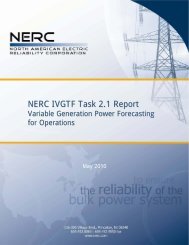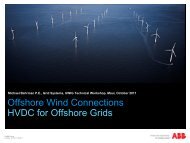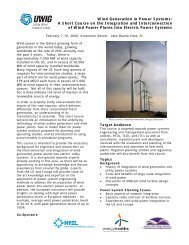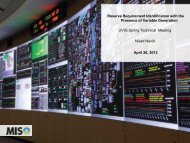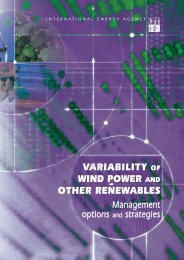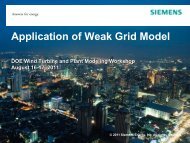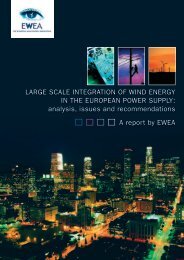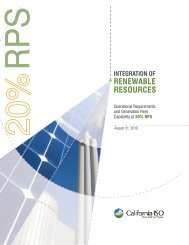Integrating Southwest Power Pool Wind to Southeast Electricity ...
Integrating Southwest Power Pool Wind to Southeast Electricity ...
Integrating Southwest Power Pool Wind to Southeast Electricity ...
Create successful ePaper yourself
Turn your PDF publications into a flip-book with our unique Google optimized e-Paper software.
B<br />
INDIVIDUAL GENERATING UNIT START-UPS<br />
Figure 6-9 shows a scatter plot of number of starts for each Entergy CC unit for the various<br />
scenarios against the number of starts for Scenario #1. It can be seen that, in general, CC starts<br />
increase in Entergy when wind is added as more cheap, but variable, energy is available from the<br />
wind without any requirement <strong>to</strong> maintain reserve for the wind. As the level of cooperation in<br />
reserve sharing and scheduling/balancing increase from Scenarios 2-4, however, the number of<br />
CC starts increase. In Scenario #2 there are fewer starts than in Scenario #1 as some of the CCs<br />
have <strong>to</strong> be held online <strong>to</strong> provide some portion of the additional reserves <strong>to</strong> cover Entergy’s<br />
portion of the wind. The number of CC starts progressively increases in Scenario #3 and<br />
Scenario #4, where Entergy CCs are used extensively <strong>to</strong> provide reserve, but the amount of spin<br />
reserve decreases significantly because of the shared contingency requirement across the<br />
footprint.<br />
Figure 6-9<br />
Individual Startups for CCs in Entergy<br />
Figure 6-10 shows a scatter plot of number of starts for each TVA CC unit for the various<br />
scenarios against the number of starts for Scenario #1. TVA can be seen <strong>to</strong> have a reduced<br />
number of starts for all CCs in all scenarios compared <strong>to</strong> Scenario 1 in general; however as with<br />
other results, there are certain units which do not follow this pattern, as their characteristics<br />
assumed in this model mean they are used differently. Scenario 2 can be seen <strong>to</strong> reduce the<br />
number of starts the most as CCs are kept online <strong>to</strong> provide the increased reserves that TVA<br />
must supply for the wind in this scenario. The number of starts decrease further in Scenario #3<br />
as scheduling is shared across the footprint and less expensive resources (as modeled here) are<br />
B-1




